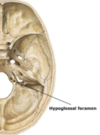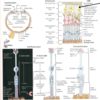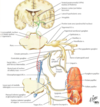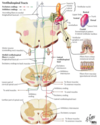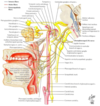Jacewicz/Foehring - Motor and Sensory CN's Flashcards
32-y/o woman with left face droop, funny taste of food on the left, and pain in the pinna of the ear on the left. She also cannot wrinkle her forehead on the left, or open her eyelid against resistance.
Where is the lesion? What other symptoms might she experience if questioned by a knowledgeable observer? Most likely dx?
- LESION: left CN VII
- OTHER SYMPTOMS: hyperacusis (INC sensitivity to certain sounds), dry eye
- DX: Bell’s palsy -> thought to most likely be a herpetic infection, with swelling of the nerve, but lyme disease and sarcoid can also do this
1. These pts all partially recover bc peripheral N regenerates (recovery can be incomplete, or to the wrong targets)
52-y/o man with cervical discectomy (sx correction of herniated disc) for radiating neck and arm pain on left. Anterolateral approach. Upon awakening, pt noted his voice was hoarse and reduced (muffled cough). No other neuro symptoms.
What is your anatomical dx?
- Injury to left recurrent laryngeal N
- NOTE: can also be injured by aortic aneurysm or mass in mediastinum; if reduced gag reflex or uvular deviation (to unaffected side), this is a sign the lesion is higher up (i.e., Vagus)
19-y/o with trouble turning head to the right. NF-1. Symptoms began a few months ago, and were slowly progressive. Exam confirms complaints. No other neuro signs.
Where is the lesion?
- Left spinal accessory N (turns head to opposite side)
- REMEMBER: SCM innervated by ipsilateral CN XI
37-y/o woman with dysarthria. Tongue protrudes to left when she sticks it out. Fasciculations on the left side too.
Where is the lesion?
- Left hypoglossal N lesion
- NOTE: this case had a metastasis of breast cancer that involved the hypoglossal canal
Name all of the cranial nerves that have a motor or PARA function, including their nuclei and function.
- RED = voluntary
- PURPLE = PARA

Note the locations of the CN nuclei. You should know this shit by now.

Good job!
Where is the motor nucleus of the trigeminal N? Where does it exit the calvarium, and what does it innervate?
- Mixed motor and sensory N
- Nuclei at MID-PONS level
- Motor fibers travel w/CN V via mandibular (V3) branch to exit calvarium via FORAMEN OVALE
- Motor V innervates mm of MASTICATION, incl. the masseter and temporalis muscles

Where does CN V exit the brainstem anatomically?
- Mid-pons level of ventral surface of brainstem

Where does Motor CN V exit the calvarium?
- Motor CN V travels along floor of Meckel’s cave, and joins with V3 (mandibular) branch of trigeminal nerve
- Exits the calvarium via the FORAMEN OVALE
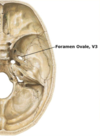
Describe the jaw jerk reflex.
- Tapping gently on lower jaw triggers muscle spindles in masseter muscle to send impulse via sensory fibers of sensory CN V, which synapse in MESENCEPHALIC nucleus of V
- Short interneuron connects w/MOTOR nucleus of V to send an impulse to the masseter muscle to contract

What do the motor fibers of the trigeminal nerve innervate?
- Muscles of mastication: masseter and temporalis
- Tensor tympani: dampens sound
- Tensor veli palatini: opens eustachian tube
- Mylohyoid: elevates hyoid bone
- Anterior belly of the digastric: elevates hyoid
How do you test motor CN V clinically?
- Have pt bite down on tongue depressor and test jaw strength -> palpate masseter and temporalis mm
1. Test bilaterally - Masseter muscle has mm spindles, and can be tested via muscle stretch reflex -> efferent arm of this reflex mediated by motor CN V
How will UMN and LMN lesions to CN V manifest themselves?
- UMN input to trigeminal motor nuclei largely bilateral, so unilateral lesions to motor cortex or corticobulbar fibers does NOT produce unilateral weakness of jaw opening or closing, but jaw jerk may be INC
- LMN: lesions of CN V or its nuclei will cause unilateral weakness of jaw closure, reduced jaw jerk, and atrophy of temporalis and masseter mm on ipsilateral side
Where are the motor/PARA nuclei of CN VII? Where do they exit the calvarium, and what do they innervate?
- Mixed motor, PARA, and sensory N
- Motor component = facial nucleus (red box) at mid-pons level -> innervates mm of facial expression and several smaller mm, like the stapedius mm
- PARA component = superior salivatory nucleus (purple box) near midline of rostral medulla -> sends preganglionic, PARA fibers through nervus intermedius to join CN VII to synapse in various ganglia with 2o innervation of lacrimal, salivary glands

Where does CN VII exit the brainstem?
- CN VII and nervus intermedius exit the brainstem at the pontomedullary junction in a region called the cerebellopontine angle
- Ventral surface of the brainstem

Describe the relationship of the facial and abducens nuclei/tracts.
- Axons of CN VII initially pass dorsal-medially, and loop over abducens nucleus (red) before turning ventrally to exit brainstem at pontomedullary junction
- NOTE: facial nucleus axons create a bulge on the floor of the fourth ventricle called the facial colliculus

Where/how does CN VII exit the calvarium?
- Facial N and nervus intermedius exit calvarium via auditory canal
- Opening of this canal is called the internal auditory meatus -> w/in auditory canal, CN VII bends ventrally to enter the facial canal and exits the skull via the stylomastoid foramen
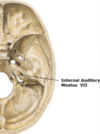
Describe the anatomy of motor VII and nucleus intermedius, incl. their target organs.
- Motor VII exits brainstem at pontomedullary junction, traverses cerebellopontine angle to enter internal auditory meatus and travel in auditory canal of petrous bone -> bends to enter facial canal, and exits cranium via the stylomastoid foramen
- Fibers (nervous intermedius) of superior salivatory nucleus exit brainstem as small root adjacent to motor VII -> travel w/motor VII to synapse in sphenopalatine (pterygopalatine) and submandibular ganglia w/2o neurons innervating salivary/lacrimal glands
- TARGETS: mm of facial expression, salivary/lacrimal glands

What do the motor fibers of the facial N innervate?
- MM of facial expression
- Stapedius muscle: dampens sound
How can you test motor CN VII?
- Ask pt to wrinkle their forehead, close their eyes tightly, and show you their teeth
- Look for symmetric furrowing of forehead, ability to symmetrically close eyes, and symmetric retraction of corners of the mouth
- Motor VII and its nerve also mediate efferent arm of the corneal reflex -> gently stroke cornea, and observe eye closure
- Also note width of palpebral fissure since weakness of orbicularis oculi m will cause widening of eye opening at rest (see attached image)

How will UMN and LMN lesions to CN VII manifest themselves?
- UMN input to motor CN VII largely bilateral for forehead mm, but unilateral for mm of lower face -> unilateral lesions to motor cortex or corticobulbar fibers causes unilateral weakness of contralateral lower face mm, but spares forehead mm (common cause is stroke)
- Unilateral LMN lesions cause ipsilateral weakness of lower face AND forehead mm -> ipsilateral hyperacusis (sensitivity to certain sounds) and dry eye may also occur -> common cause is Bell’s palsy
1. See attached image

Where is the nucleus of CN IX? Where does it exit the calvarium, and what does it innervate?
- Mixed motor, PARA, sensory N
- MOTOR: nucleus ambiguus (red box) near ponto-medullary junc; innervates stylopharyngeus m
- PARA: inferior salivatory nucleus (purple box) near midline of medulla sends preganglionic, PARA fibers via IX to lesser petrosal N to synapse in otic ganglion w/2o innervation of parotid gland

Where does CN IX exit the brainstem?
- Exits at junction b/t pons and medulla
- Ventral surface of brainstem

Where does CN IX exit the calvarium?
- Jugular foramen (w/X, XI, and internal jugular)

Describe the anatomy of motor N IX, and its target organs.
- Nucleus ambiguus fibers exit calvarium via jugular foramen and innervate stylopharyngeal m to raise pharynx during talking and swallowing
- Efferent fibers from inferior salivatory nucleus travel w/CN IX, and split off as lesser petrosal N before synapsing in otic ganglion -> 2o neurons innervate parotid gland
- TARGETS: stylopharyngeus m, and parotid gland
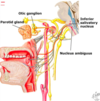
How is CN IX function tested clinically?
- Testing motor function difficult, and usually not done bc only innervates stylopharyngeal m
- N integrity routinely tested under sensory func by testing gag reflex, of which CN IX mediates the sensory component (afferent):
1. Motor component is shared by IX and X, but more so by X
2. Tested by gently touching posterior pharynx on L and R separately, and watching for motor, or gag response, and elevation of soft palate
Where is the nucleus of CN X? Where does it exit the calvarium, and what does it innervate?
- Mixed motor, PARA, and sensory
- MOTOR: served by nucleus ambiguus (red box) near lateral medulla, and innervates mm of soft palate, pharynx, and larynx
- PARA: dorsal motor nucleus of Vagus (purple box) near midline of medulla sends preganglionic, PARA fibers to intramural ganglia associated with the heart, lung, and digestive tract (red arrow pts to nerve)

Where does CN X exit the brainstem?
- Series of rootlets between inferior olive and inferior cerebellar peduncle
- Ventral surface of brainstem

How does CN X exit the calvarium?
- Jugular foramen (w/IX, XI, internal jugular)
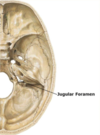
Describe the anatomy of motor nerve X.
- Nucleus ambiguus fibers travel in CN X to innervate pharyngeal, laryngeal, and palate mm -> exits calvarium via jugular foramen
- Preganglionic fibers of dorsal motor nucleus travel with CN X to synapse in intramural ganglia in walls of heart, lungs, and gut







